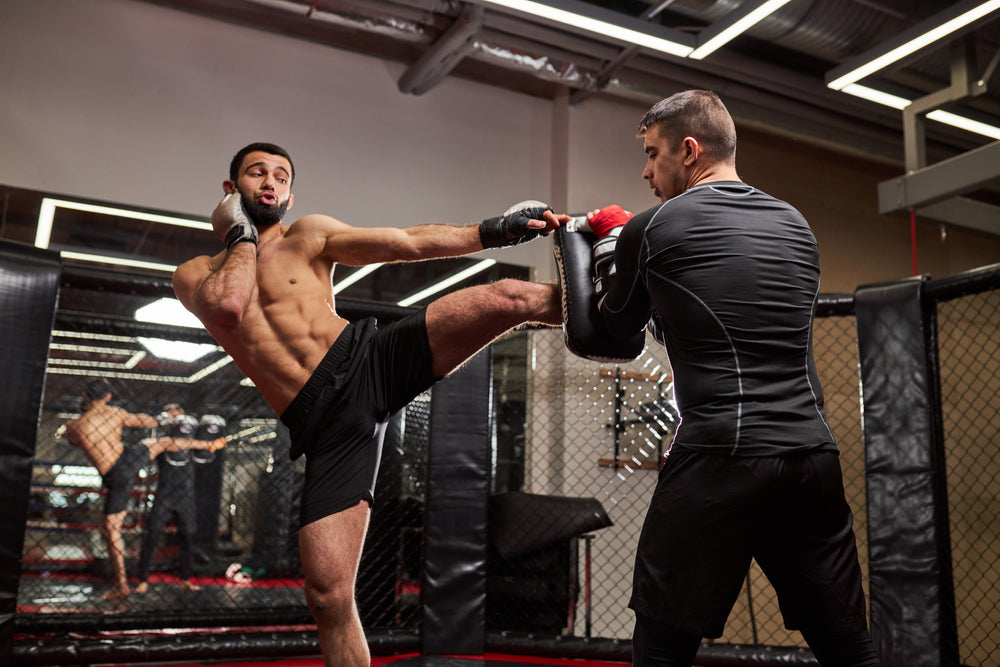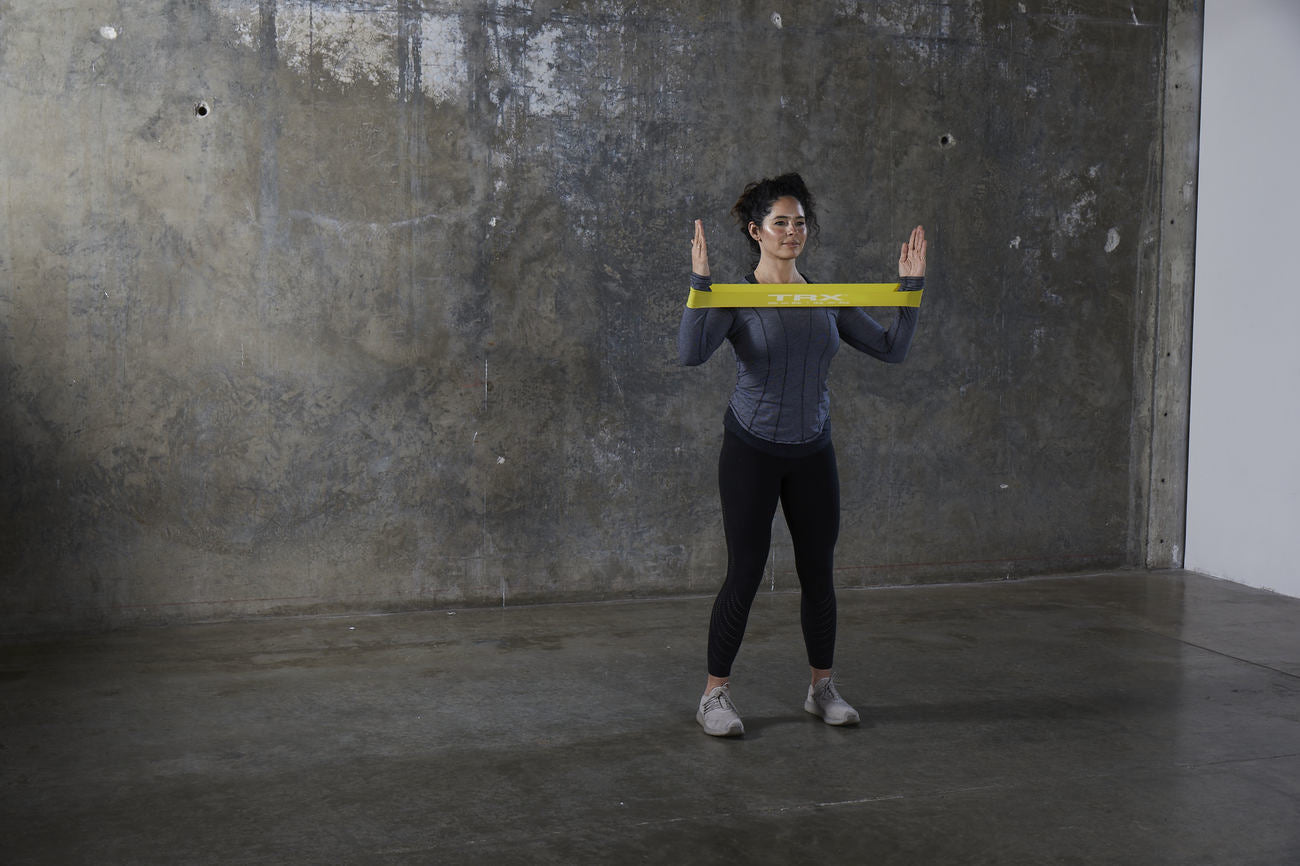The heavy thud of a 100-pound bag swings through the air, punctuated by grunts and the squeak of shoes on rubber mats.
MMA workouts stand miles apart from those Instagram-perfect gym sessions you might see online. These fighters don't train to fill out a t-shirt; they're preparing their bodies for war in the cage.
Every drop of sweat has purpose, from explosive burpees that mimic takedown defense to endless rounds on the speed bag. What might look like chaos to outsiders follows a carefully planned system that builds warriors, not just athletes. Ready to peek behind the curtain of an MMA fighter's training camp?
TLDR: How to Do an MMA Workout in <30 Seconds
-
Mix it up with a 60/30/10 split (technical drills/conditioning/strength work) to match real fight demands
-
Choose exercises that translate to fighting (sprawls over burpees, battle ropes over treadmills)
-
Give your body time to recover. Serious fighters need 2-3 full days between intense sessions
What Makes an Effective MMA Workout Program
Step into any MMA gym and you'll spot the difference right away, fighters doing work that makes regular gym routines look like child's play.
They're not just getting fit, they're building bodies that can handle everything from takedowns to submissions to three rounds of striking.
MMA demands a unique mix of skills. Fighters need explosive power (to move 200+ pound opponents), endless stamina (for those long grappling exchanges), and the gas tank to throw clean punches even when tired.
Then there's the flexibility you need to survive in the cage; try defending submissions with tight hips, and the mental game that keeps you thinking straight when someone's trying to choke you out.
Smart training breaks it all down. Morning sessions for ground work, evenings for striking, with strength work carefully placed between.
Some days that means easing up on weights to save energy for sparring. Other days, it's pure conditioning when the techniques are dialed in.
The body needs time to handle these demands. Good programs spread the load across the week, matching tough days with easier ones. It's not about training harder, it's about training smarter.
What Physical Requirements Do MMA Fighters Need?
When fighters step into that cage, they need more than just technique to survive. Their bodies must handle everything from explosive exchanges to grinding battles against the fence.
Fighters absolutely need raw power to control opponents, strength relative to their weight for quick moves, explosive force for strikes, and the endurance to keep pushing when their arms feel like lead.
That gas tank better hold up too, those five-minute rounds feel like forever when someone's trying to take your head off.
Training Periodization for Fighters
Training changes dramatically based on how close fight night looms.
Eight-plus weeks out, fighters focus on building their engine, heavy compound lifts, and fixing technical gaps.
But once fight camp hits (those crucial 6-8 weeks before), everything shifts to sharpening tools and building that cardio.
Off-season means grinding through deadlifts and power work while keeping technical training steady but not overwhelming.
Fight camp flips the script, drilling takes center stage while weights maintain what's already built.
The whole thing only works if strength coaches and fight coaches stay in sync, making sure nobody's getting crushed between hard sparring and heavy lifting days. Recovery isn't optional; it's part of the plan.
MMA Strength Training Fundamentals
Most fighters getting into MMA might think all they need is endless rounds on the heavy bag and sparring. They’re wrong.
The right strength training makes all the difference between landing that knockout punch or getting caught with your hands down in round three.
Unlike those guys posing in the mirror at your local gym, MMA athletes need strength that works in the cage.
That means pairing up heavy lifts with quick, explosive movements. It's kind of like teaching your muscles to be both a tank and a sports car.
Essential Compound Exercises for MMA Fighters
The backbone of any fighter's strength program comes down to movements that work multiple muscle groups at once. Research highlighting maximal strength's key role in grappling and explosive qualities relevant to MMA. [1]
These exercises might look simple, but they pack a serious punch:
-
Squats: The foundation of fighting power. Keep those knees tracking over your toes and your back straight. If you're training at home, a suspension trainer helps perfect your form
-
Deadlifts: This one's all about the backside muscles, from your hamstrings up through your back. Master the basic form before adding weight
-
Pressing Movements: Both standing and lying down presses build the pushing power needed for strikes. Start with bodyweight versions to groove the movement pattern
When you're ready to add more explosive work, mix in some jumping exercises twice a week. Just don't schedule them right after your heavy lifting days, your body needs time to bounce back.
MMA Fighters Develop Power and Explosiveness
Quick bursts of power can make or break a fight. Jump training helps build that explosive strength fighters need when it counts. Box jumps and broad jumps lead into more complex drills that match real fighting movement. Adding TRX support to jumping exercises helps build that power safely, while the Rip Trainer develops rotational strength for strikes and throws.
Try Our 3-Day MMA Workout Plan
Here’s a practical 3-day weekly training template that balances strength, conditioning, and skill work. This routine blends traditional gym lifts and TRX exercises, perfect for fighters training with limited equipment or traveling.
-
Day 1: Strength Focus
-
Squats or TRX Assisted Squats: 4 sets of 6 reps
-
Deadlifts or TRX Rip Trainer Deadlifts: 4 sets of 5 reps
-
Overhead Press or TRX Overhead Press: 3 sets of 8 reps
-
Core Stability (Planks, TRX Plank): 3 sets, 45 seconds hold
-
Day 2: Conditioning & Technical Drills
-
Jump Rope intervals: 5 rounds of 3 minutes work, 1 minute rest
-
MMA Shadowboxing with footwork: 4 rounds of 3 minutes
-
Bag or Pad Work: 4 rounds of 3 minutes focusing on striking combos
-
TRX Suspension Trainer Rows (grappling strength): 3 sets of 10 reps
-
Day 3: Power & Mobility
-
Box Jumps or TRX Jump Squats: 3 sets of 8 reps
-
TRX Rip Trainer Rotational Strikes: 3 sets of 10 reps each side
-
Dynamic Mobility Drills (hip openers, shoulder circles): 10 minutes
-
MMA Clinch Work Drills (partner or bag): 10 minutes
Adjust the volume and rest between sets depending on your experience and recovery. Beginners might start with fewer sets and longer rest.
Week-by-Week Progression Guide
Over 12 weeks, increase intensity gradually. For main lifts, use percentage-based progressions starting at about 65% of your one-rep max and increasing to 85%. Accessory exercises follow double progression: increase reps first, then add resistance.
Include a deload week every 4th week with reduced volume to prevent burnout.
Try an Example Training Session
Here’s a breakdown of a typical strength session:
-
Warm-up: 5 minutes jump rope, dynamic stretches
-
Squats: 4 sets, 6 reps (2-minute rest)
-
Deadlifts: 4 sets, 5 reps (2-3 minute rest)
-
TRX Overhead Press: 3 sets, 8 reps (90-second rest)
-
Planks: 3 sets, hold 45 seconds (60-second rest)
-
Cool-down: Stretch major muscle groups
Don’t Forget These MMA-Specific Conditions
Conditioning in MMA isn’t just about running laps; it’s about preparing your body to handle the unpredictable pace of a fight. This means training your energy systems in ways that mimic striking, grappling, and explosive transitions so you can push hard without burning out.
Energy System Training for Combat Sports
Fights demand all three energy systems:
-
Aerobic: Base endurance to recover between rounds and maintain work rate.
-
Anaerobic Alactic: Short bursts of maximal effort, like explosive takedowns.
-
Anaerobic Lactic: Sustained high-intensity efforts during clinch battles or ground scrambles.
Combat sports physiology emphasizing anaerobic and aerobic system contributions in MMA. [2]
Workouts should reflect this. Aerobic base can come from low impact cardio like swimming or running, or even options such as cycling or rowing, which reduce joint strain while still building endurance. Anaerobic training uses HIIT protocols, such as 30-second sprints or bag work with short rests. This approach conditions your body to fight hard and recover fast.
Agility and Movement Training
Footwork drills improve your ability to stay balanced, close distance, and evade strikes. Start simple with ladder drills or cone drills, then add reactive elements like partner shadowing or reaction lights.
Integrate these with technical drills for better carryover. TRX Suspension Trainer can assist with balance and core control during these movements.
How to Recover and Prevent Injuries During MMA Training
Training hard is vital, but so is recovery. Sleep, nutrition, and stress management have huge impacts on your performance.
Simple recovery methods like foam rolling, stretching, and hydration help muscle repair. Avoid overtraining signs: persistent soreness, declining performance, or irritability.
Nutrition for MMA Performance
Nutrition plays a huge role in how fighters train, perform, and recover.
Macronutrient needs shift depending on training phases. During heavy training blocks, fighters often increase carbohydrates to fuel high-intensity work, while protein intake remains steady to support muscle repair.
Use fats to provide long-term energy and joint support; in weight management periods, carbs are adjusted carefully to balance energy with weight.
As for hydration, it’s important to drink consistently throughout the day, not just during workouts.
Since dehydration can affect strength, focus, and endurance, fighters often include electrolytes, minerals like sodium and potassium, to replace what’s lost through sweat in intense sessions.
Finally, when it comes to meal timing, eating a carb-rich meal with some protein a few hours before training provides fuel, while a post-training meal or shake with protein and carbs helps speed recovery and restore glycogen, the stored form of energy in muscles.
Sleep and Stress Management
Sleep is a critical component of fighting performance, influencing both physical recovery and cognitive function, such as reaction time, decision-making, and focus under pressure.
To support high-quality rest, aim for 7-9 hours per night. Minimize exposure to screens or bright lights before bed to help your body’s natural circadian rhythm.
In addition, stress management techniques like deep breathing, progressive muscle relaxation, or mindfulness exercises can lower cortisol levels, which not only improves sleep quality.
It also enhances training adaptation by allowing your body to recover more efficiently between sessions.
Incorporating these approaches consistently helps fighters stay sharp, recover faster, and maintain peak performance.
Common MMA Training Mistakes to Avoid
Many fighters fall into the trap of training too much or neglecting certain areas.
-
Avoid “more is better.” Quality beats quantity every time.
-
Don’t skip recovery days. Your body needs time to adapt.
-
Balance strength, conditioning, and skill work. Overloading one can cause fatigue and injury.
-
Communicate with your coaches to align training goals and avoid conflicting schedules.
Balancing Multiple Training Demands
Managing multiple training styles feels like juggling chainsaws; one wrong move and everything falls apart.
Every fighter faces this puzzle: how to blend striking, grappling, and strength work without burning out.
-
Map out a 12-week competition prep, with 8 weeks for building and 4 for sharpening
-
Keep 6 hours between major sessions
-
Drop one element if another suffers
-
Add light weeks every 4-6 weeks (40% reduced intensity)
Getting coaches to work together might seem challenging, but it's not impossible.
-
Share a digital training log
-
Meet monthly to sync up
-
Send quick weekly updates
Your body sends warning signals. Learn to listen.
-
Morning heart rate up 7+ beats? Take it easy
-
Can't grip well? You're beat
-
Three bad nights of sleep? Cut work by 25%
-
Nagging pains = rest day needed
No one wants to admit they're doing too much, but smart fighters know when to pull back. The best training plan isn't the hardest, it's the one you can sustain.
Implementing Your MMA Training Program
When starting an MMA-focused fitness routine, it’s important to begin with a clear understanding of your current abilities.
Once you know where you stand, start with foundational strength and conditioning exercises that build overall power, endurance, and mobility, while gradually incorporating technical skill work like striking, grappling, or footwork drills.
Tools like TRX for MMA can be especially valuable at this stage, since suspension training helps fighters develop functional strength, core stability, and explosive movement patterns that directly translate into performance inside the cage.
As you gain consistency, use progression markers, such as increased weight, higher intensity, or more complex combinations, to determine when it’s safe to advance to intermediate or advanced training methods, ensuring steady improvement while minimizing the risk of injury.
Equipment and Facility Requirements
You don’t need a fancy gym. Essential items include:
-
TRX Suspension Trainer for bodyweight resistance
-
TRX YBell for versatile weighted exercises
-
TRX Rip Trainer for rotational power
-
Jump rope for conditioning
-
Basic weights if available
These tools are portable, so you can train anywhere, home, gym, or on the road.
Tracking Progress and Making Adjustments
Tracking your training is a powerful way to measure progress and optimize performance.
To begin, identify key performance indicators that reflect fighting-relevant fitness, such as increased strength in compound lifts and faster reaction times.
Next, document each session by noting exercises, weights, repetitions, sets, and subjective factors like energy levels, soreness, or focus, which helps reveal patterns in performance and recovery over time.
Finally, use this information to adjust your program when progress stalls or fatigue accumulates, whether that means increasing intensity, adding rest days, or modifying exercise selection.
Take Your MMA Journey to The Next Level
Getting started in MMA isn't rocket science, just good old sweat and dedication. A solid mix of strength work, cardio (those grueling hill sprints), proper technique, and enough rest between training sessions gets you where you need to be.
Those who've stuck it out know it's tough, but they wouldn't have it any other way. A local gym with qualified coaches and supportive training partners makes all the difference.
The cage might look intimidating now, but with time and practice, it becomes home. Before you know it, you'll be the one helping newcomers find their footing.
For tools that can enhance your strength and conditioning, check out TRX Best Sellers to find equipment suited for fighters at any level.
You can also explore the TRX Research page to see the science behind suspension training and how it supports performance, recovery, and injury prevention.
References
-
https://pmc.ncbi.nlm.nih.gov/articles/PMC9323058/
-
https://pmc.ncbi.nlm.nih.gov/articles/PMC11894756/



